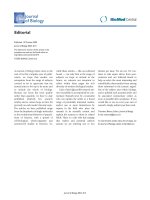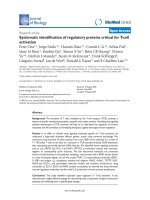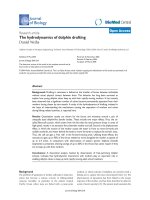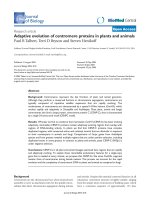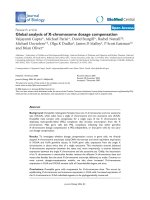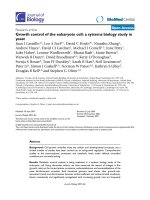Báo cáo sinh học: "Phenotypic plasticity of body pigmentation in Drosophila: Relationships among estimates of inbreeding depression, dominance" potx
Bạn đang xem bản rút gọn của tài liệu. Xem và tải ngay bản đầy đủ của tài liệu tại đây (418.06 KB, 8 trang )
Original
article
Relationships
among
estimates
of
inbreeding
depression,
dominance
and
additive
variance
for
linear
traits
in
Holsteins
I
Misztal
TJ
Lawlor
N
Gengler
1
1 Ani!nal
and
Dairy
Science
Department,
University
of
Georgia,
Livestock- Poultry
Building,
Athens,
GA
30602;
2
Holstein
Association,
Brattleboro,
VT
05302,
USA
(Received
26
November
1996;
accepted
20
May
1997)
Summary -
Estimates
of
dominance
and
additive
variances
were
obtained
for
14
linear
traits.
The
data
included
600 678
first
parity
records
on
14
linear
traits
in
Holsteins.
The
model
included
management
groups,
age
at
calving,
additive
and dominance
effects,
and
regression
on
inbreeding
percentage.
The
estimate
of
the
dominance
variance
was
9.8%
of
the
phenotypic
variance
for
body
depth,
8.0%
for
strength,
6.9%
for
stature,
and
was
less
than
5%
for
the
remaining
traits.
The
additive
variance
ranged
from
12.2%
for
foot
angle
to
45.3%
for
stature.
No
clear
relationship
was
found
between
the
estimates
of
dominance
and
additive
variance;
larger
negative
estimates
of
the
inbreeding
depression
were
associated
with
higher
estimates
of
the
dominance
variance.
type
traits
/
dominance
/
inbreeding
/
variance
components
Résumé -
Relations
entre
estimées
de
dépression
de
consanguinité,
de
variances
génétiques
additives
et
de
dominance
pour
les
caractères
de
conformation
en
race
Holstein.
Des
estimées
de
variances
génétiques
additives
et
de
dominance
ont
été
obtenues
pour 14
caractères
de
conformation
en
race
Holstein
(600
678
résultats
de
première
lactation).
Le
modèle
incluait
les
effets
groupes
de
conduite,
l’âge
au
vêlage,
les
effets
génétiques
additifs
et
de
dominance
et
la
régression
sur
le
taux
de
consanguinité.
La
variance
génétique
de
dominance
a
été
évaluée
à
9,8
%
de
la
variance
phénotypique
pour
la
profondeur
du
corps,
à
8,0
%
pour
la
puissance,
6,9
%
pour
la
taille
et
moins
de
5 %
pour
les
autres
caractères.
La
variance
génétique
additive
a
varié
de
12,2
%
pour
l’angle
du
pied
à
45,3
%
pour
la
taille.
On
n’a
pas
trouvé
de
relation
claire
entre
les
estimées
de
variance
additive
et
de
variance
de
dominance.
On
a
trouvé
que
la
dépression
de
consanguinité
était
d’autant
plus
forte
que
l’estimée
de
variance
de
dominance
était
élevée.
caractère
de
conformation
/
dominance
/
consanguinité
/
composantes
de
variance
*
On
leave
from
Facult6
universitaire
des
sciences
agronomiques,
B-5030
Gembloux,
Belgium
INTRODUCTION
Genetic
evaluations
for
farm
animals
are
currently
based
on
the
additive
model
(Henderson,
1985).
Dominance
effects
were
ignored
for
two
reasons.
First,
compu-
tations
of
evaluations
with
dominance
were
unfeasible
computationally
for
larger
pedigrees.
Second,
the
importance
of
dominance
for
the
evaluation
was
not
well
established;
this
importance
can
be
rated
by
the
fraction
of
the
dominance
variance
in
the
total
variance
for
a
given
trait.
However,
good
estimates
of
the
dominance
variance
were
not
available
because
of
a
lack
of
reliable
procedures
that
would
1)
use
the
animal
model
to
exploit
all
the
dominance
information
in
the
data,
2)
be
resis-
tant
to
selection
bias,
and
3)
be
able
to
use
large
and
complete
data
to
ensure a
low
sampling
error
(Misztal
et
al,
1995).
For
comparable
accuracy,
the
estimates
of
the
dominance
variance
need
to
be
derived
from
data
sets
20-200
times
larger
than
the
estimates
of
the
additive
variance
(Chang,
1988:
Hoeschele
and
VanRaden,
1991).
Estimates
of
dominance
variance
were
obtained
in
the
past
either
with
simplified
models
(eg,
VanRaden
et
al,
1992),
or
from
small
data
sets
(eg,
Rodriguez-Almeida
et
al,
1995).
Recent
developments
have
made
computations
with
dominance
in
the
model
feasible.
The
discovery
of
rules
to
invert
the
dominance
relationship
matrix
and
de-
velopments
with
computing
algorithms
have
made
the
creation
of
the
mixed model
equations
with
the
dominance
effect
feasible
for
very
large
data
sets
(Hoeschele
and
VanRaden,
1991).
Computing
refinements
resulted
in
evaluation
with
dominance
in
the
model
requiring
less
than
twice
the
memory
and
computing
time
of
the
additive
only
procedures
(Misztal,
1997).
The
use
of
method
R
has
allowed
for
estimation
of
variance
components
for
very
large
data
sets
(Reverter
et
al,
1994);
method
R
was
shown
to
be
as
resistant
to
several
types
of selection
bias
as
REML
(Snelling,
1994;
Kaiser
and
Golden,
1994).
The
feasibility
of
computations
with
dominance
has
created
an
interest
in
identifying
traits
that
have
a
significant
dominance
variance
and
thus
could
benefit
from
evaluation
with
dominance
in
the
model.
Predictions
of
the
dominance
effects
could
be
utilized
as
special
combined
abilities
in
a
mating
system
(DeStefano
et
al,
1992).
One
large
source
of
traits
is
type
traits.
Since
1983,
the
Holstein
Association
of
America
has
collected
data
on
14
linear
type
traits
(Thompson
et
al,
1983).
These
traits
are
scored
on
a
unified
scale
of
one
to
50,
and
have
a
similar
phenotypic
standard
deviation
of
about
6.0,
thus
simplifying
comparisons
among
them.
Type
evaluations
are
used
in
an
index
with
production
traits
to
maintain
a
functional
cow.
The
first
goal
of
this
paper
was
to
estimate
dominance
variances
for
linear
type
traits.
A
large
number
of
linear
traits
provides
the
opportunity
for
examining
rela-
tionships
between
dominance
and
other
effects.
As
suggested
for
fitness
traits
by
Falconer
(1989),
if
the
gene
action
is
close
to
overdominant,
it
is
possible
that
the
dominance
variance
is
high
for
traits
with
a
low
additive
variance.
This
leads
to
a
theory
that
traits
with
low
heritability
in
the
narrow
sense
are
more
likely
to
have
a
high
heritability
in
the
broad
sense.
In
dairy
cattle,
that
theory
was
supported
by
studies
on
production
traits
(VanRaden
et
al,
1992)
and
fertility
(Hoeschele,
1991).
Since
type
traits
have
a
wide
range
of
different
additive
variances,
the
second
goal
of
the
paper
was
to
examine
this
theory
in
application
to
type
traits.
Because
precise
estimates
of
the
dominance
variance
require
large
data
sets,
and
such
sets
may
not
be
available,
it
would
be
interesting
to
find
out
whether
the
dominance
variance
can
be
predicted
indirectly.
One
such
possibility
is
through
the
use
of
inbreeding
depression,
which
can
be
predicted
accurately
from
much
smaller
data
sets.
It
would
be
expected
that
a
higher
dominance
variance
would
correspond
to
a
higher
magnitude
of
inbreeding
depression.
The
last
goal
of
the
paper
was
to
examine
the
relationship
between
estimates
of
dominance
variance
and
inbreeding
depression.
MATERIALS
AND
METHODS
The
data
included
first-records
on
the
14
linear
traits
for
the
first
600 678
Holsteins
selected
from
a
data
set
sorted
by
herd
number
and
used
by
the
Holstein
Association
of
America
for
genetic
evaluation
in
July
1995.
Additionally,
pedigrees
of
most
sires
were
available.
Each
trait
was
analyzed
separately
using
the
model
where
y
is
a
600
678
x
1
vector
of
records,
(3
is
a
23
697
x
1
vector
of
management
and
age
at
calving
effects,
0
is
the
coefficient
of
inbreeding
depression,
a
is
a
732
644
x
1
vector
of
additive
animal
effect,
f
is
a
1 269 690
x
1
vector
of
dominance
parental
effect,
b
is
a
600 678
x
1
vector
of
inbreeding
coefficients,
and
X,
Z
and
Q
are
matrices
or
vectors
that
relate
records
to
respective
effects.
The
variances
are
where
CF’2
is
the
additive
variance
and
or’
is
the
dominance
variance,
A
is
an
additive
relationship
matrix,
and
F
is
a
dominance
parental
relationship
matrix
as
defined
in
Hoeschele
and
VanRaden
(1991).
The
average
inbreeding
for
animals
was
0.7%
for
all
animals
but
increased
to
2.4%
for
animals
born
in
1992;
inbreeding
was
considered
in
A
but
not
in
F.
Estimates
were
obtained
by
method
R
as
in
Misztal
(1997).
Each
trait
was
analyzed
six
times,
each
time
with
a
different
subset
of
the
data
generated
by
a
random
number
generator;
each
subset
contained
50%
of
the
full
data
set.
The
convergence
criterion
was
ri
=
1
!
0.0001,
where
ri
is
the
regression
for
random
effect
i,
which
corresponds
to
a
numerical
error
in
the
estimates
of
variances
of
0.5%
or
less
of
the
total
variance.
Sampling
standard
deviation
of
the
estimates
was
calculated
as
standard
deviation
of
the
estimates
from
different
subsamples.
RESULTS
AND
DISCUSSION
Table
I
presents
estimates
of
inbreeding
depressions
and
variances
as
well
as
ratios
of
the
estimates
of
variances
for
the
14
traits.
All
variances
are
expressed
as
percentages
of
the
phenotypic
variance.
While
standard
deviations
in
estimates
for
inbreeding
depression
among
the
six
samples
were
no
larger
than
0.001
and
therefore
stable,
they
were
up
to
0.6%
for
the
additive
variance
and
up
to
1.2%
for
the
dominance
variance.
Most
of
the
standard
deviations
for
the
additive
variance
were
due
to
incomplete
convergence
(r
i
differed
from
1
by
up
to
0.0001).
However,
the
changes
for
the
dominance
variance
reflected
a
limited
amount
of
dominance
information
in
the
data
and,
therefore,
relatively
large
sampling
variances.
Estimates
of
the
inbreeding
depression
were
small,
with
the
largest
magnitude
being
for
body
depth
at
-0.07.
Only
two
other
estimates
had
a
magnitude
larger
than
0.05:
stature
and
strength.
The
estimates
were
positive
for
several
traits,
the
largest
being
for
udder
depth
at
0.03.
Positive
estimates
could
result
from
scale
reversal,
where
lower
scores
are
more
desirable.
An
alternative
explanation
for
udder
depth
was
provided
by
a
reviewer,
who
suggested
that
inbred
cows
milk
less
so
the
udders
are
less
full
and
not
as
deep.
The
estimates
of
the
additive
variance
were
mostly
similar
to
earlier
estimates
using
first
records
and
the
animal
model
(Misztal
et
al,
1992).
Heritabilities
were
0.07
larger
for
udder
height
and
udder
cleft,
0.06
larger
for
rump
angle,
and
0.05
larger
for
udder
depth.
Heritability
was
smaller
by
0.06
for
dairy
form;
other
estimates
differed
by
no
more
than
0.02.
Larger
differences
are
most
likely
to
be
due
to
new
age
adjustment
factors.
After
age
adjustments
were
included
in
the
model,
Lawlor
et
al
(1995)
found
large
changes,
particularly
for
dairy
form
and
udder
depth.
An
increase
in
the
estimate
of
heritability
of
0.05
to
0.20
for
stature
when
age
adjustments
were
fit
in
the
model
was
found
in
a
study
on
various
dominance
models
(Misztal
et
al,
1997).
The
estimate
of
the
dominance
variance
was
8%
of
the
phenotypic
variance
or
larger
for
only
two
traits:
body
depth
and
strength.
Two
other
estimates,
for
stature
and
dairy
form,
were
above
5%.
The
remaining
ten
estimates
were
below
5%.
All
traits
with
larger
estimates
of
dominance
were
body
traits.
The
estimates
of
the
dominance
variance
were
within
10-29%
of
the
estimates
of
the
additive
variance,
with
a
mean
of
17%.
Thus,
for
type
traits,
the
dominance
variance
is,
on
average,
six
times
lower
than
the
additive
variance,
and
only
a
small
part
of
the
total
genetic
variance.
The
inbreeding
depression,
a
linear
measure,
is
more
related
to
standard
devi-
ation,
a
linear
measure,
than
to
variance,
a
quadratic
measure.
Therefore,
tests
on
relationships
between
the
inbreeding
depression
and
the
dominance
variance
in-
volved
estimates
of
the
dominance
standard
deviation.
Table
II
shows
estimates
of
the
phenotypic
and
dominance
standard
deviations
and
the
ratio
of
the
estimates
of
inbreeding
depression
to
dominance
standard
deviation.
In
absolute
terms,
the
av-
erage
ratio
of
estimates
of
inbreeding
depression
per
1%
of
inbreeding
to
estimates
of
dominance
standard
deviation
was
2.32%.
Figure
1
plots
estimates
of
the
inbreeding
depressions
against
those
of
the
domi-
nance
standard
deviations.
Larger
inbreeding
depressions
were
generally
associated
with
larger
dominance
variances.
All
positive
estimates
of
inbreeding depression
are
associated
with
low
estimates
of
dominance
variance.
On
average,
the
dominance
standard
deviation
could
be
predicted
as
1.03-10.94
x
inbreeding
depression,
with
an
R2
=
0.63
(table
III).
Thus,
the
prediction
accuracy
is
moderate.
Figure
2
plots
estimates
of
the
dominance
variance
against
those
of
the
addi-
tive
variance.
On
average,
the
estimates
of
the
dominance
variance
increase
slightly
with
increasing
additive
variance.
The
regression
of
the
estimates
of
dominance
on
additive
variances
is
significant,
but
has
a
low
RZ
of
0.31
(table
III).
Higher
estimates
of
the
additive
variance
generally
corresponded
to
higher
estimates
of
the
dominance
variance.
Thus,
the
hypothesis
that
traits
with
low
heritability
in
the
narrow
sense
are
more
likely
to
have
a
high
heritability
in
the
broad
sense
cannot
be
confirmed
for
type
traits.
Some
of
the
less
conclusive
results
of
this
study
could
be
due
to
the
use
of
an
insufficiently
large
data
set.
First,
many
full
sibs
obtained
through
embryo
transfer
are
in
different
herds,
and
many
of
them
have
not
been
selected
in
the
data
set.
Subsequently,
the
’dominance
content’
in
the
data
was
small
and
the
sampling
variance
of
the
dominance
estimates
was
high.
Second,
inbreeding
was
calculated
without
considering
the
missing
pedigrees
as
in
VanRaden
(1992).
Also
most
pedigrees
of
females
born
prior
to
1980
were
missing.
Subsequently
inbreeding
depression
was
underestimated.
In
conclusion,
the
estimates
of
the
dominance
variance
for
type
traits
are
medium
for
some
traits
and
small
for
most.
Larger
negative
estimates
of
the
inbreeding
depressions
were
associated
with
higher
estimates
of
the
dominance
variance.
Larger
estimates
of
dominance
variances
were
generally
associated
with
higher
additive
variances,
but
that
association
was
weak.
ACKNOWLEDGMENTS
Helpful
comments
by
Keith
Bertrand,
Matt
Culbertson
and
the
two
anonymous
reviewers
are
greatfully
appreciated.
Ignacy
Misztal
acknowledges
the
financial
support
of
the
Holstein
Association
of
America.
Nicolas
Gengler,
who
is
Charge
de
Recherches
of
the
Fonds
National
de
la
Recherche
Scientifique,
Belgium,
acknowledges
its
financial
support.
Partial
computing
support
was
by
the
National
Center
for
Supercomputing
Applications.
REFERENCES
Chang
HA
(1988)
Studies
on
estimation
of
genetic
variances
under
non-additive
gene
action.
Ph
D
dissertation,
University
of
Illinois,
Urbana,
USA
DeStefano
AL,
H6schele
I
(1992)
Utilization
of
dominance
variance
through
mate
alloca-
tion
strategies.
J
Dairy
Sci
75,
1680-1690
Falconer
DS
(1989)
Introduction
to
Quantitative
Genetics,
3rd
ed.
Longman,
Burnt
Mill,
Harlow
Henderson
CR
(1985)
Best
linear
unbiased
prediction
of
nonadditive
genetic
merits
in
noninbred
populations.
J
Anim
Sci
60, 111-117
Hoeschele
I,
VanRaden
PM
(1991)
Rapid
inversion
of
dominance
relationship
matrices
for
noninbred
populations
by
including
sire
by
dam
subclass
effects.
J
Dairy
Sci
74,
557-569
Hoeschele
I
(1991)
Additive
and
nonadditive
genetic
variance
in
female
fertility
of
Holsteins.
J
Dairy
Sci
74,
1743-1752
Kaiser
CJ,
Golden
BL
(1994)
Heritability
estimation
and
breeding
value
prediction
using
selected data.
J
Anim
Sci
72
(Suppl
1),
147
(Abstr)
Lawlor
TJ,
Weigel
KA,
Misztal
I
(1995)
Accounting
for
age
and
stage
of
lactation
at
time
of
classification
in
genetic
evaluations
of
type
trait.
J
Dairy
Sci
78
(Suppl 1),
156
Misztal
I
(1997)
Estimation
of
variance
components
with
large-scale
dominance
models.
J
Dairy
Sci
80,
965-974
Misztal
I,
Fernando
RL,
Grossman
M,
Lawlor
TJ,
Lukaszewicz
M
(1995)
Dominance
and
epistatic
effects
in
genetic
evaluation.
Animal
Sci
Papers
Reports
13,
251-266
Misztal
I,
Lawlor
TJ,
Fernando
RL
(1997)
Dominance
models
by
Method
R
for
stature
in
Holsteins.
J
Dairy
Sci
80,
975-978.
Misztal
I,
Lawlor
TJ,
Short
TH,
VanRaden
PM
(1992)
Multiple-trait
estimation
of
variance
components
of
yield
and
type
traits
using
an
animal
model.
J
Dairy
Sci
75,
544-551
Reverter
A,
Golden
BL,
Bourdon
RM
(1994)
Method
R
variance
components
procedure:
application
on
the
simple
breeding
value
model.
J
Anim
Sci
72,
2247-2253
Rodriguez-Almeida
FA,
Van
Vleck
LD,
Wilham
RL,
Northcutt
SL
1995.
Estimation
of
non-
additive
genetic
variances
in
three
synthetic
lines
of
beef
cattle
using
an
animal
model.
J
Anim
Sci
73,
1002-1011
1
Snelling
WM
(1994)
Genetic
analyses
of
stayability
measures
of
beef
females.
Ph
D
Dis-
sertation
Colorado
State
Univ,
Fort
Collins
Thompson
JR,
Lee
KL,
Freeman
AE,
Johnson
LP
(1983)
Evaluation
of
a
linearized
type
appraisal
system
for
Holstein
cattle.
J
Dairy
Sci
66,
325-331
VanRaden
PM
(1992)
Accounting
for
inbreeding
and
crossbreeding
in
genetic
evaluation
of
large
populations.
J
Dairy
Sci
75,
3136-3144
VanRaden
PM,
Lawlor
TJ,
Short
TH,
Hoeschele
I
(1992)
Use
of
reproductive
technology
to
estimate
variances
and
predict
effects
of
gene
interactions.
J
Dairy
Sci
75,
2892-2901

